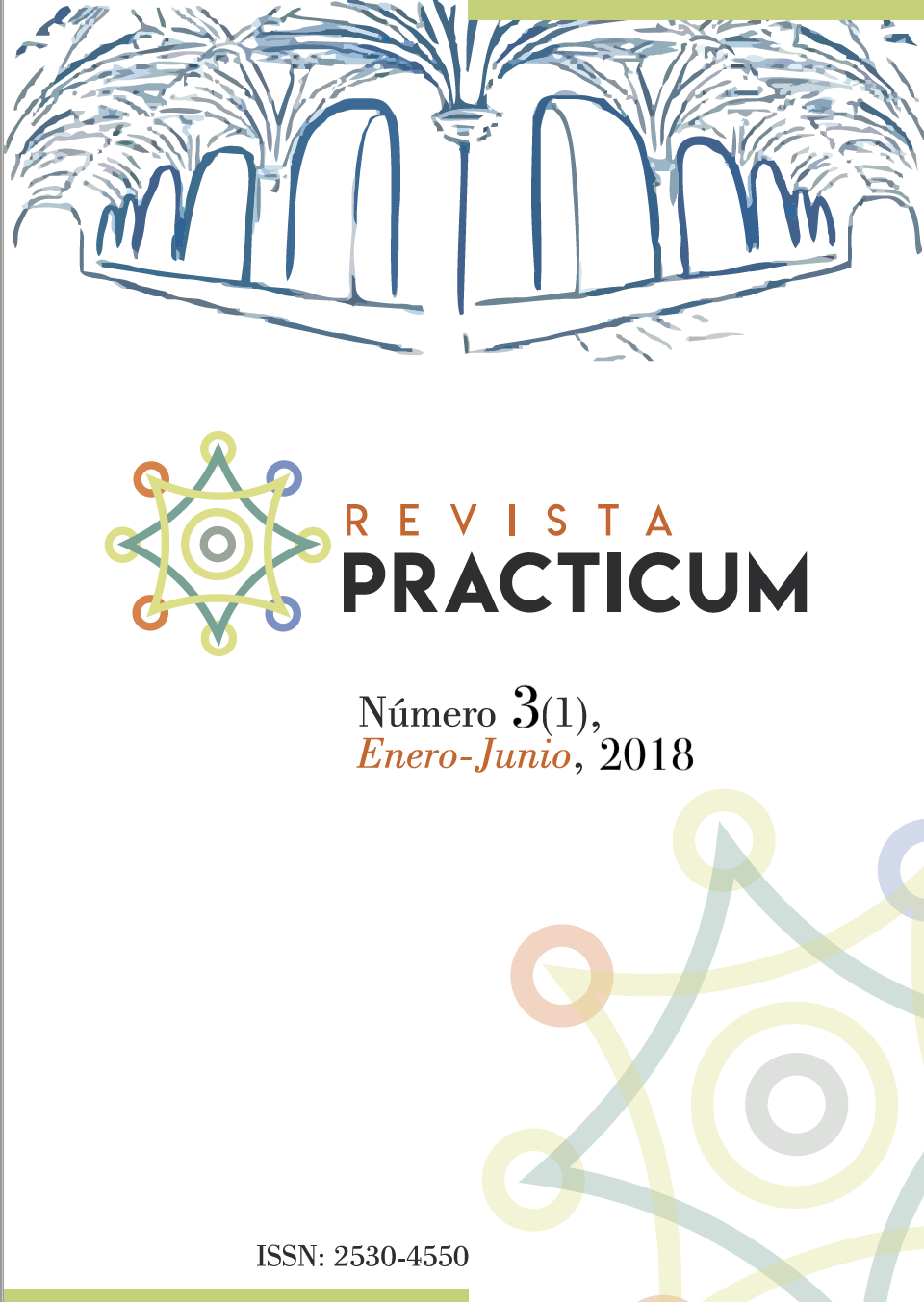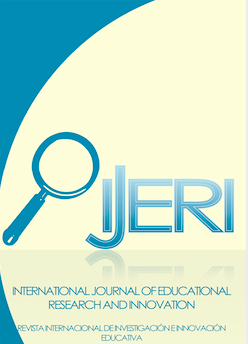Formas de participación durante el prácticum en una comunidad de aula como oportunidades de aprendizaje de la profesión de maestro
DOI:
https://doi.org/10.24310/RevPracticumrep.v3i1.8272Palabras clave:
Participación, prácticum, interacción, estudiante de maestro, aprendizaje observacionalResumen
Este artículo presenta algunos de los resultados de una investigación centrada en conocer las formas de participación conjunta de una maestra practicante y una maestra tutora en una comunidad de aula durante el prácticum. La investigación se inscribe en una perspectiva sociocultural del aprendizaje entendido como participación. La metodología corresponde a un estudio de caso único conformado por una maestra de Educación Infantil, dieciocho alumnos y una estudiante de prácticum. Se analizan quince jornadas de aula distribuidas a lo largo de un semestre escolar. Los resultados permiten identificar nueve formas de participación conjunta diferentes, presentes durante el prácticum, que para la estudiante en prácticas representan grados variados de implicación y co-responsabilidad en dicha comunidad de aula. La distribución de las diferentes formas de participación a lo largo del prácticum no sigue, como cabría esperar, una tendencia creciente, de menos a más participación por parte de la practicante, sino que muestra oscilaciones importantes que comportan avances y retrocesos en el grado de implicación en las tareas del aula, incluso en aquellas en las que ya había logrado cotas de implicación elevadas. Dichas oscilaciones se explican de acuerdo a aspectos concretos de la práctica sociocultural del aula en la cual ocurren.
Descargas
Métricas
Publicación Facts
Perfil de revisores N/D
Información adicional autores
Indexado: {$indexList}
-
Indexado en
- Sociedad Académica/Grupo
- N/D
- Editora:
- Universidad de Málaga
Citas
Billett, S. (2014). Mimetic learning at work. Learning in the circumstances of practice. Dordrecht, Países Bajos: Springer. doi: 10.1007/978-3-319-09277-5
Coll, C., Bustos, A., y Engel, A. (2008). Las comunidades virtuales de aprendiza je. En C. Coll, y C. Monereo (Eds.), Psicología de la educación virtual (pp. 299- 320). Madrid, España: Morata.
Coll, C., Onrubia, J., & Mauri, T. (2008). Ayudar a aprender en contextos educativos:el ejercicio de la influencia educativa y el análisis de la enseñanza. Revista de Educación, Mayo-Agosto, 33-70. Recuperado de http://www.revistaeducacion.mec.es/re346/re346_02.pdf
Colomina, R., Onrubia, J. y Rochera, M. (2001). Interactividad, mecanismos de influencia educativa y construcción del conocimiento en el aula. En C. Coll, J. Palacios, y M. Marchesi (Eds.), Desarrollo psicológico y educación. Volumen II. Psicología de la educación escolar (pp. 437-458). Madrid, España: Alianza.
Edwards, A. (2005). Let’s get beyond community and practice: The many meanings of learning by participating. Curriculum Journal, 16, 49-65. doi: https://doi.org/10.1080/0958517042000336809
Engeström, Y. (2001). Expansive learning at work: Toward an activity theoretical reconceptualization. Journal of education and work, 14, 133-156. Recuperado de http://www.tandfonline.com/doi/pdf/10.1080/13639080020028747
Filliettaz, L., Trébert, D., & Rémery, V. (2012). Relation tutorale et configuration de participation a? l’interaction: le cas de la formation professionnelle des éducatriceset éducateurs de l’enfance [Relación tutorial y configuración de la participaciónen la interacción: el caso de la formación profesional de educadores y educadoras de infantes]. Ponencia presentada en el 2° Coloquio internacional de didáctica profesional, aprendizaje y desarrollo profesional, Universidad de Nantes, Nantes,Francia. Recuperado de https://archive-ouverte.unige.ch/unige:27171
Hodkinson, P., y Hodkinson, H. (2004). A constructive critique of communities of practice: moving beyond Lave and Wenger. Paper presentado en Integrating workand learning – contemporary issues’ seminar series 2004. Sidney, Australia. Recuperado de http://www.voced.edu.au/content/ngv%3A37993
Lave, J., y Wenger, E. (1991). Situated learning: Legitimate peripheral participation.Cambridge, Reino Unido: Cambridge University Press.
Lave, J., y Wenger, E. (2002). Legitimate peripheral participation in communities of practice. En M. Lea, y K. Nicoll (Eds.), Distributed Learning. Social and cultural approaches to practice (pp. 56-63). London, Inglaterra: Routledge.
Matusov, E. (1998). When solo activity is not privileged: Participation and internalization models of development. Human Development, 41, 326-349. doi: http://dx.doi.org/10.1159/000022595
Mauri,T., Clarà, M., Ginesta, A. y Colomina, R. (2013). La contribución al aprendizaje en el lugar de trabajo de los equipos docentes universitarios. Un estudio exploratorio. Infan-cia y Aprendizaje, 36(3), 341-360. doi: https://doi.org/10.1174/021037013807533025
Rogoff, B. (1995). Observing sociocultural activity on three planes: Participatory appro-priation, guided participation and apprenticeship. En J. Wertsch, P. del Río, y A. Álvarez (Eds.), Sociocultural studies of mind (pp. 139-164). Cambridge, Reino Unido: Cambrid-ge University Press.
Rogoff, B., Paradise, R., Arauz, R. M., Correa-Chavez, M., & Angelillo, C. (2003). Firsthand learning through intent participation. Annual Review of Psychology, 54, 175–203. doi: https://doi.org/10.1146/annurev.psych.54.101601.145118
Schatzki, T.R. (2002). The site of the social: A philosophical account of the constitu-tion of social life and change. Philadelphia, Estados Unidos: University of Pennsylvania Press.
Schatzki, T.R. (2010). Materiality and social life. Nature and Culture, 5, 123-149. doi: http://dx.doi.org/10.3167/nc.2010.050202
Toledo, B., y Mauri, T. (2014). Construcción social de las prácticas de una comunidad de aula de educación infantil: Análisis de la actividad conjunta de la maestra tutora, maes-tra practicante y alumnos/as. En M. A. Flores, C. Coutinho, y J. A. Lencastre (Comps.), Atas do congresso Formac?a?o e trabalho docente na sociedade da aprendizagem. Orga-nizado no a?mbito da International Study Association on Teachers and Teaching (ISATT) e do Centro de Investigac?a?o em Estudos da Crianc?a (CIEC) (pp. 489-500). Braga, Por-tugal: CIEC, UMinho.
Toledo, B., y Mauri, T. (2015). Dinámicas de participación en una comunidad de aula: Oportunidades de aprendizaje del futuro maestro durante el período de prácticum. Pa-peles de Trabajo sobre Cultura, Educación y Desarrollo Humano, 11, 121-127. Recupe-rado de http://www.uam.es/otros/ptcedh/2015v11_pdf/v11n2sp.pdf
Toledo, B. y Mauri, T. (2016). Aprendizaje como participación durante el prácticum en un aula de Educación Infantil. Estudios Pedagógicos, 42, 343-363. doi: http://dx.doi.org/10.4067/S0718-07052016000200020Wenger, E. (1998/2001). Comunidades de práctica. Aprendizaje, significado e identidad (G. Sánchez, Trad.; Título original: Communities of practice: Learning, meaning and identity). Barcelona: Paidós.
Yin, R. (2006). Case study methods. En J. Green, G. Camilli, y P. Elmore (Eds.), Hand-book of complementary methods in education research (pp. 111-122). Mahwah, Esta-dos Unidos: Lawrence Erlbaum y AERA.
Young, R. (2008). Chapter two: Foundations for the study of practice. Lenguage Lear-ning, 58(2), 9-47. doi: http://dx.doi.org/10.1111/j.1467-9922.2009.00489.x
Descargas
Publicado
Cómo citar
Número
Sección
Licencia
La aceptación de la obra conlleva por parte del autor/a ceder a la Revista Prácticum en exclusiva los derechos de reproducción, distribución y venta de su obra en todo el mundo, tanto en formato digital como de papel, CD-rom, etc.
Igualmente los autores/as cederán a la Revista Prácticum los derechos de difusión, comunicación pública en internet y redes informáticas, buses de datos, como cualquier otro portal o dispositivo electrónico para consultas online de sus contenidos y extractos, y bajo las condiciones del portal, repositorios o la base de datos donde se halle la obra.
La Revista Prácticum anima a los autores la publicación y difusión de sus artículos y obras en sus páginas web personales, equipos de investigación, los repositorios institucionales y bases de datos científicas.
Todos los contenidos publicados en Revista Practicum están sujetos a la licencia Creative Commons Reconocimento-NoComercia-Compartirigual 4.0 cuyo texto completo puede consultar en <http://creativecommons.org/licenses/by-nc-sa/4.0>











8.png)








